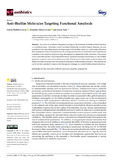Mostrar el registro sencillo del ítem
Anti-biofilm molecules targeting functional amyloids
| dc.creator | Matilla Cuenca, Leticia | es_ES |
| dc.creator | Toledo Arana, Alejandro | es_ES |
| dc.creator | Valle Turrillas, Jaione | es_ES |
| dc.date.accessioned | 2022-01-12T08:17:12Z | |
| dc.date.available | 2022-01-12T08:17:12Z | |
| dc.date.issued | 2021 | |
| dc.identifier.issn | 2079-6382 | |
| dc.identifier.uri | https://hdl.handle.net/2454/41732 | |
| dc.description.abstract | The choice of an effective therapeutic strategy in the treatment of biofilm-related infections is a significant issue. Amyloids, which have been historically related to human diseases, are now considered to be prevailing structural components of the biofilm matrix in a wide range of bacteria. This assumption creates the potential for an exciting research area, in which functional amyloids are considered to be attractive targets for drug development to dissemble biofilm structures. The present review describes the best-characterized bacterial functional amyloids and focuses on anti-biofilm agents that target intrinsic and facultative amyloids. This study provides a better understanding of the different modes of actions of the anti-amyloid molecules to inhibit biofilm formation. This information can be further exploited to improve the therapeutic strategies to combat biofilm-related infections. | en |
| dc.description.sponsorship | Work in the laboratory of J.V. is funded by grant RTI2018-096011-B-I00 from the Spanish Ministry of Science, Innovation and Universities. We acknowledge support of the publication fee by the CSIC Open Access Publication Support Initiative through its Unit of Information Resources for Research (URICI). | en |
| dc.format.extent | 18 p. | |
| dc.format.mimetype | application/pdf | en |
| dc.language.iso | eng | en |
| dc.publisher | MDPI | en |
| dc.relation.ispartof | Antibiotics, 10 (7), 795 | en |
| dc.rights | © 2021 by the authors. Licensee MDPI, Basel, Switzerland. This article is an open access article distributed under the terms and conditions of the Creative Commons Attribution (CC BY) license. | en |
| dc.rights.uri | http://creativecommons.org/licenses/by/4.0/ | |
| dc.subject | Biofilm | en |
| dc.subject | Amyloids | en |
| dc.subject | Antibiotic resistance | en |
| dc.subject | Peptides | en |
| dc.subject | Polyphenols | en |
| dc.title | Anti-biofilm molecules targeting functional amyloids | en |
| dc.type | info:eu-repo/semantics/article | en |
| dc.type | Artículo / Artikulua | es |
| dc.contributor.department | Ciencias de la Salud | es_ES |
| dc.contributor.department | Osasun Zientziak | eu |
| dc.rights.accessRights | info:eu-repo/semantics/openAccess | en |
| dc.rights.accessRights | Acceso abierto / Sarbide irekia | es |
| dc.identifier.doi | 10.3390/antibiotics10070795 | |
| dc.relation.publisherversion | https://doi.org/10.3390/antibiotics10070795 | |
| dc.type.version | info:eu-repo/semantics/publishedVersion | en |
| dc.type.version | Versión publicada / Argitaratu den bertsioa | es |



